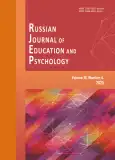Использование мультимедийной презентации при обучении юридической лексике английского языка студентов неязыковых вузов
- Авторы: Перцевая Е.А.1, Кюрегян А.Л.2, Кузьмина А.П.3
-
Учреждения:
- ФГАОУ ВО «Самарский государственный экономический университет»
- ФГБОУ ВО «Самарский государственный технический университет»
- ФГБОУ ВО «Самарский государственный университет путей сообщения»
- Выпуск: Том 16, № 4 (2025)
- Страницы: 166-185
- Раздел: Педагогические исследования
- Статья опубликована: 30.09.2025
- URL: https://journal-vniispk.ru/2658-4034/article/view/348986
- DOI: https://doi.org/10.12731/2658-4034-2025-16-4-899
- EDN: https://elibrary.ru/GPIIQL
- ID: 348986
Цитировать
Полный текст
Аннотация
Обоснование. Юридический английский является языком документов и нормативно-правовых актов, отличающихся точностью и фиксированностью формулировок. В настоящее время в переводах студентов неязыковых вузов отмечается тенденция к замещению значения лексических единиц языка права общеупотребимым значением или использованию калькирования и транскрибирования слова, что обуславливает необходимость более подробного изучения юридической лексики для исправления ошибок в интерпретации и понимании значения конкретных слов и словосочетаний. Процесс определения наиболее сложных аспектов лексики в настоящее время вызывает затруднения вследствие сокращения количества часов, выделяемых на практические занятия, а также увеличения количества человек в одной группе по иностранному языку. Использование мультимедийной презентации является одним из способов наглядной систематизации лексических единиц языка права, выполняемым каждым студентом индивидуально.
Цель. Основная цель состоит в определении и систематизации наиболее проблемных областей в изучении юридической лексики посредством выполнения студентами мультимедийной презентации для последующей интеграции полученных данных в процесс преподавания иностранных языков на юридических специальностях в неязыковых вузах.
Материалы и методы. Метод теоретического анализа научной и педагогической литературы применялся для оценки эффективности мультимедийной презентации как педагогического инструмента в обучении иностранному языку. Педагогический эксперимент позволил определить наиболее проблемные области в изучении профессионально-ориентированной лексики. Метод описания использовался для определения порядка сбора данных и их последующей интерпретации.
Результаты. В ходе эксперимента студенты неязыковых вузов произвели систематизацию сложных для освоения слов английского языка юридической сферы и представили их в виде мультимедийной презентации. Анализ полученного материала позволил выделить три основных источника ошибок при освоении английской лексики языка права: чтение, написание и ошибочное понимание семантики слов. Применение мультимедийной презентации способствует повышению вовлеченности студентов в процесс изучения иностранного языка посредством самостоятельного определения проблемных для понимания лексических единиц, а также внести элементы индивидуальной работы в практические занятия по иностранному языку.
Об авторах
Екатерина Александровна Перцевая
ФГАОУ ВО «Самарский государственный экономический университет»
Автор, ответственный за переписку.
Email: kmilyutina@mail.ru
ORCID iD: 0000-0002-7289-5080
SPIN-код: 4233-1064
кандидат филологических наук, доцент, доцент кафедры лингвистики и иноязычной деловой коммуникации
Россия, ул. Советской Армии, 141 г. Самара, 443090, Российская Федерация
Амалия Левиковна Кюрегян
ФГБОУ ВО «Самарский государственный технический университет»
Email: amleku@mail.ru
ORCID iD: 0000-0002-0822-4274
SPIN-код: 1390-9021
кандидат филологических наук, доцент, доцент кафедры иностранных языков
Россия, ул. Молодогвардейская, 244, г. Самара, 443100, Российская Федерация
Александра Петровна Кузьмина
ФГБОУ ВО «Самарский государственный университет путей сообщения»
Email: fadeevaaleksa@yandex.ru
ORCID iD: 0000-0002-0833-7885
SPIN-код: 7651-8798
кандидат педагогических наук, доцент кафедры лингвистики
Россия, 1-й Безымянный пер., 18, г. Самара, 443066, Российская Федерация
Список литературы
- Говенько, А. М. (2022). Мультимедийная презентация и её возможности при обучении иностранным языкам. В Современные тенденции развития аграрной науки: Сборник научных трудов международной научно-практической конференции (Брянск, 1–2 декабря 2022 г., сс. 367–370). Брянск: Брянский государственный аграрный университет. EDN: https://elibrary.ru/ZURMKC
- Анюшенкова, О. Н. (2025). Использование ментальных карт в обучении иностранному языку. Мир науки, культуры, образования, (1)(110), 115–117. https://doi.org/10.24412/1991-5497-2025-1110-114-117. EDN: https://elibrary.ru/OQLBYB
- Иванишина, А. Н. (2023). Визуализация и её использование в процессе обучения иностранному языку. В Стратегия развития образования для будущего России: Материалы Международной научно-практической конференции, приуроченной к Году педагога и наставника в Российской Федерации (Владимир, 16–17 марта 2023 г., Т. Часть 1, сс. 61–66). Владимир: Государственное автономное образовательное учреждение дополнительного профессионального образования Владимирской области «Владимирский институт развития образования имени Л. И. Новиковой». EDN: https://elibrary.ru/VAYWWM
- Киченко, А. А. (2010). Методика обучения профессионально-ориентированному иноязычному общению студентов посредством мультимедийных презентаций: автореферат диссертации кандидата педагогических наук. Москва. EDN: https://elibrary.ru/QFAMSN
- Клевцова, Н. И. (2003). Методико-дидактические принципы создания и использования мультимедийных учебных презентаций в обучении иностранному языку: автореферат диссертации кандидата педагогических наук. Москва. EDN: https://elibrary.ru/NMEUYL
- Куманькина, И. П. (2018). Технология скрайбинга в изучении английского языка. В Актуальные проблемы германистики и методики преподавания иностранных языков: сборник научных трудов по материалам VIII Международной научно-практической конференции (Саранск, 14–15 ноября 2018 г., сс. 136–141). Саранск: Мордовский государственный педагогический институт имени М. Е. Евсевьева. EDN: https://elibrary.ru/ZCAQQX
- Лазарева, А. С. (2007). Использование мультимедийной презентации для обеспечения качества обучения говорению на иностранном языке: автореферат диссертации кандидата педагогических наук. Тамбов. EDN: https://elibrary.ru/NOOPNZ
- Мухачева, В. В., & Плаксина, И. В. (2020). Использование мультимедийных презентаций при введении лексики на уроках иностранного языка. В Общество — наука — инновации: сборник статей Международной научно-практической конференции (Омск, 9 мая 2020 г., Т. Часть 2, сс. 101–105). Уфа: ООО «ОМЕГА САЙНС». EDN: https://elibrary.ru/DFRPMT
- Ханжина, Т. В. (2019). К вопросу использования мультимедийных технологий в обучении лексике. В Языковые и культурные реалии современного мира: Материалы IV Всероссийской научно-практической конференции студентов, аспирантов и молодых учёных (Пенза, 29 апреля 2019 г., сс. 102–107). Пенза: Пензенский государственный технологический университет. EDN: https://elibrary.ru/FGKJJK
- Bloch, J. (2009). The design of an online concordancing program for teaching about reporting verbs. Language Learning & Technology, (13)(1), 59–78. https://doi.org/10.64152/10125/44168
- Đurovića, Z., & Dlabača, T. (2025). Lexical profiling and building technical glossaries. Transportation Research Procedia, (83), 450–456. https://doi.org/10.1016/j.trpro.2025.03.012. EDN: https://elibrary.ru/ONYUUB
- Lewis, M. (1993). The lexical approach: The state of ELT and a way forward. Hove: Language Teaching Publications.
- Nunan, D. (1999). Second Language Learning and Teaching. New York: Newbery House.
- Nicklin, C., Bailey, D., McLean, S., Kim, A. Y., Kang, H., & Vitta, J. P. (2025). Applying lexical sophistication models to wordlist development: A proof-of-concept study. Research Methods in Applied Linguistics, 4(1). https://doi.org/10.1016/j.rmal.2024.100175
- Thornbury, S. (2002). How to teach vocabulary. London: Longman Pearson.
Дополнительные файлы










